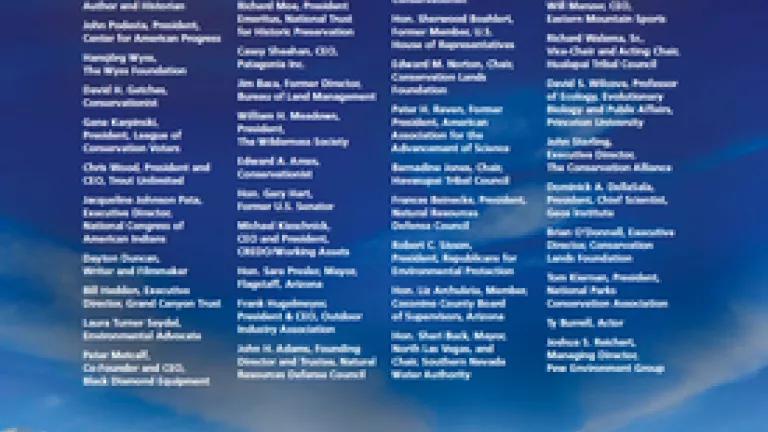Former Clinton Secretary of Interior Calls on Obama Administration to Protect Wilderness, Wildlife, & Oceans

The administration’s commitment to wilderness is diminished, but President Obama can still take decisive action to protect America's natural heritage - starting with the Grand Canyon.
President Obama, in many ways, has distinguished himself as a visionary in promoting policies that seek to transform and green our nation’s economic and energy polices. In the face of the worst assaults on the environment in modern times, he has often stood tall. But in terms of protecting the nation’s incomparable wildlife, natural lands, and ocean coasts, the President has fallen quite short in fulfilling this promise. This is particularly the case in terms of wilderness, where the oil and gas industry, in league with their Republican champions, have initiated a full out assault on what was once one of the more bipartisan ideals: conserving America’s wilderness.
As discussed in previous postings, the fight to protect the nation’s last remaining wilderness has been fraught with contention and unfortunate setbacks. Most recently on June 1, the Obama administration issued a policy memo that retreats from an earlier commitment by the Interior Department to safeguard millions of acres of federal wild lands not permanently protected as wilderness. This is the second notable decision by the administration on wilderness. In April, the administration’s budget negotiators agreed to a Republican rider that defunded measures to protect wilderness (not to mention the fact that they also granted a rider delisting the endangered grey wolf). The June memo goes a step further by disavowing longstanding federal regulations that require the federal government to actively protect federal wilderness.
The deference the administration has shown to its most vocal critics has not gone unnoticed. A number of key Republicans and industry stalwarts, whose contempt for wilderness borderlines on the obsessive, declared victory and heaped praise on the administration’s decision. But this retreat did not go unchallenged by those who typically would be seen as sympathetic to the plight of a presidential administration trying to navigate a complex political environment. Most notable was criticism raised by President Clinton’s former Interior Secretary, Bruce Babbitt. At a speech today at the National Press Club, former Secretary Babbitt was unequivocal in expressing his strong disappointment with the most recent wilderness decision taken by current Interior Secretary Salazar, a decision that would not have happened but for a Congress whose hostility for wilderness is unprecedented. And Babbitt knows a thing or two about politically calculated decisions to appease critics by embracing compromises on the management of natural resources. Babbitt recalled their acquiescence in agreeing to a rider to increase timber harvest in the nation’s national forests and the harm it further engendered on attacks against the environment:
We made the appeasement mistake when I was Secretary. Back in 1995, another Congress, in thrall to then House Speaker Gingrich, inserted a “salvage rider” to increase logging in our National Forests onto an appropriations bill. Pressured by the timber industry and the House leadership, we capitulated and President Clinton signed the bill with the rider intact. It was a big mistake that set off a prolonged and destructive episode in the history of our National Forests
The decision in 1995 did little to stem the Republican rhetoric, and had the opposite impact by empowering Congress to seek more draconian measures to harm the environment. But President Clinton recognized this critical error and committed to a “no rider” policy for the remainder of his administration. Furthermore, he embarked upon an ambitious plan to expand protection of many of the nation’s greatest natural treasures. John Podesta, Chief of Staff for Clinton, weighed in today on the Babbitt speech, noting the similarities with current events and how the Clinton administration was able to turn their mistake into something positive:
That’s why one of my proudest accomplishments from the Clinton administration is working with Secretary of the Interior Bruce Babbitt to protect these national treasures. Together, we helped President Clinton protect more land in the lower 48 states than any president since Teddy Roosevelt, from the north rim of the Grand Canyon to President Lincoln’s Cottage to Pompey’s Pillar in Montana to the California Coastal National Monument that includes 20,000 islands, rocks, and reefs.
As fortune would have it, President Obama has before him a similar chance to correct the record and champion the nation’s wild lands. Pending before his administration is an opportunity to extend for 20-years, moratorium prohibiting new uranium and mining claims near the Grand Canyon. The Grand Canyon – an iconic place as there ever was – is under threat by uranium mining plans. NRDC and our partners have been collectively advocating for the administration to extend a longstanding moratorium that would continue to protect this national treasure from uranium mining –an activity as dirty, toxic, and damaging as any other manmade operation found on this planet. The moratorium is set to expire in June, so a decision by the administration needs to be made within the next few weeks. This is a tremendous opportunity for the President to demonstrate his leadership in protecting one of the very symbols of American conservation – and that would translate into change we can finally believe in.
TAKE ACTION: Tell Secretary Salazar that now is the time to protect America’s last best wild places.

